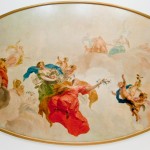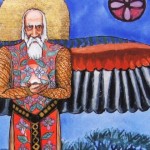Magic is no instrument
Magic is the end
— Leonard Cohen
The issue of magic came up in the comments following a recent post about being embarrassed by some parts of Paganism. This is also a topic that Drew Jacob has taken up recenlty on his site Rogue Priest.
Magic is a vague term that has been used to describe a wide array of cultural practices, from sleight of hand (legedermain) to summoning demons, from healing with herbs to divination from the entrails of animals, from calling down pagan deities to prayers to a monotheistic god for blessings. In fact, the term is so vague as to be virtually useless, except to raise controversy. Nevertheless, since “magic” seems inexorably intertwined with Paganism, I will attempt to unpack the term here.
The term “magic” is used in at least four different ways by Pagan authors. First, “magic” is used to describe practices which seek to project the magician’s will on the natural world by supernatural or occult means. (By “supernatural”, I mean those means which are not recognized by the natural sciences. By “occult”, I mean those means which are hidden from positivistic science.) Second, “magic” is used to express the feminist reclamation of women’s willpower (either symbolically or in practice). Third, “magic” is used to describe a form of psychotherapy that involves religious symbolism and ritual. Finally, “magic” is used to describe a “re-enchantment” of the world, meaning an expanded consciousness of the radically interconnected world of which we are a part.
Sometimes, different definitions of magic are used by the same Pagan author. As will be seen below, Starhawk is a good example of this, as she sometimes writes as if magic is the power of mind over matter, but other times she steps back from that position, de-ephasizing the practical forms of magic in favor of the psychological forms.
Magic as an expression of the magician’s will
“Magic is the science and art of causing change to occur in conformity with the will.” — Aleister Crowley
In her PhD work, Persuasions of the Witch’s Craft, Tanya Luhrmann describes Neopagan magic from the perspective of a participant observer:
“[Neopagan] Magicians also often speak of forces or energies which are not generally recognized by science. … Magicians also talk about other forces, powers or currents, which pervade the universe and can be generated by the knowledgeable. These are often described as if they were electro-magnetic currents, but the analogy is loose. The basic idea is that the forces are both part of the world, accessible by human effort, and yet somehow not like more familiar forces like gravity. … These forces are rather badly defined but they are thought to exist, and to be elicited and directed in magical rituals. It is as if magicians think of themselves as creating an electrical storm in rituals, and dispensing bolts of lightning to chosen targets.
“So magicians tend to conceptualize reality as a dynamic flux shot through with subtle forces and unknown energies. What they call their magical ‘technology’ — the mechanism by which their magic works — involves an account of the ‘correspondences’ between reality’s different bits. […]
“Modern magic holds that thought affects the world directly — even though it is patently obvious that most of the time it does not, without action. The magical idea is that mind affects matter in very special circumstances, namely when the magician frees himself from the shackles of everyday awareness and focuses his entire being on obtaining his goal. … one must represent the goal in imagination, and focus on that image with total concentration and intense desire. Rituals help this to happen. They change the circumstances so that the appropriate concentration can occur.
“Magic is ultimately the conception that mind alters matter when mind … focuses completely upon a particular goal.”
The description above is not unsympathetic, but it does reflect the perspective of someone who has not bought into the two fundamental premises of magic as an expression of will:
1. That human will power is a real force, that alone, when concentrated, can effect supernatural changes in the material world.
2. That the universe is tied together by a system of hidden correspondences (analogous to, but distinct from, the natural laws recognized by scientists), and that by discovering the pattern of these correspondences magicians can effect supernatural changes in the material world.
See King and Skinner, Techniques of High Magic: A Manual of Self-Initiation (1976) (quoted by Luhrmann). I refer to this theory as the instrumental view of magic.
In The Spiral Dance, Starhawk defines magic, in part, as “the art of sensing and shaping the subtle, unseen forces that flow throughout the world …” In Dreaming the Dark, she writes that magic is a “technology” or “applied science” “of how energy makes patterns and patterns direct energy”. While she emphasizes the psychological function of spells, she also claims that “spells can also influence the external world.” Like so many New Age authors, Starhawk invokes the “new physics” to explain how magic works. The “new physics” often functions for authors like Starhawk as a talisman that “magically” eliminates the need to actually explain anything.
Starhawk defines magic as “will”. Similarly, Michael York defines magic as “the product of extreme will”, contrasting it with religious worship (which he identifies as the core of paganism). The notion of magic as will or control has been problematic at least since the time of Iamblichus. Imablichus was a third century CE Neoplatonist who taught that that personal union with the Neoplatonic One was achievable through “theurgy”, a religio-magical ritual process of invocation that purported to draw the powers of the cosmos into the adept. Theurgy was distinguished from profane magic in that it required proper piety and intention. Neopagan magic has been compared by Ronald Hutton and others to ancient theurgy. Hutton observes that theurgy, as it was practiced by Iamblichus, was considered by some to be sacrilegious, as it implied that divine powers could controlled by human means.
Magic as an expression of the reclamation of women’s willpower
Magic is also used an expression of modern feminist witchcraft and, along with witchcraft, is part of the reclaiming of women’s political, social, and personal power. This is something Starhawk explores in the fourth chapter of Dreaming the Dark, entitled “Reclaiming Personal Power: Magic as Will”, in which she describes the “magical” process of changing the consciousness of a woman named Joy and helping her to “find her power”. Both “magic” and “witch” are powerful words for Starhawk, precisely because they make us uncomfortable and create the possibility of changing consciousness.
Some feminist witches go so far as to declare (following Michelet) that all women are witches by virtue of being women. As Cynthia Eller explains:
“For spiritual feminists, being a witch, saying one is a witch, is most often a feminist statement, the symbolic encapsulation of a feminist political program. The witch is the powerful outsider, the despised and excluded person who is threatening the established order. All women are witches, according to some spiritual feminists, whether they want to be or not, because they possess nature (female) powers linked to childbirth and their intimate communion with nature, and they are therefore compelled to be outsiders to a male-dominant society.”
Magic, in this context, is practiced as a form of self-affirmation of women’s right to express and achieve their own desires. In this sense, magic tends to be more psychological than practical.
Magic as therapy
According to Susan Greenwood, “Many magical practices are often initially psychotherapeutic techniques which aim to balance the forces or energies within to bring the magician to an awareness of his/herself in relation to divinity.” In this sense, “magic” is largely indistinguishable from other forms of Neopagan ritual which aim at psychological integration. As Jungian psychologist and Wiccan priestess Vivianne Crowley writes: “The most important piece of magic we will ever do is the magic we do on ourselves.”
In The Spiral Dance, Starhawk defines magic also as “the art […] of awakening deeper levels of consciousness beyond the rational”.
“Spells are extremely sophisticated psychological tools that have subtle but important effects on a person’s inner growth. … Practical results may be far less important than psychological insights that arise during magical working. … Spells go one step further than most forms of psychotherapy. They allow us not only to listen to an interpret the unconscious but also to speak to it, in the language it understands. Symbols, images, and objects used in spells communicate directly with the Younger Self, who is the seat of our emotions and who is barely touched by the intellect. We often understand our feelings and behavior, but find ourselves unable to change them. Through spells, we can attain the most important power–the power to change ourselves.”
While Starhawk does not deny the power of magic to “influence the external world”, she says in Dreaming the Dark: “As a means of gaining power-over, magic is not very effective — hence its association with self-deception, illusion and charlatanry in our society.” In contrast, magic is effective for “calling forth of power-from-within”.
Magic as a re-enchanting the world
The fourth and last sense in which the term “magic” is used by Neopagans refers to an altered consciousness of the nature of existence, a “re-enchanting” of the world, meaning a (re-)discovery of the “unseen” connections present in ourselves, in the natural world, and between ourselves and the natural world.
In Dreaming the Dark, Starhawk writes:
“Magic is art — that is, it has to do with forms, with structures, with images that can shift us out of the limitations imposed by our culture in a way that words alone cannot, with visions that hint at possibilities of fulfillment not offered by the empty world.”
In this way, magic resembles poetry. Indeed, Starhawk writes that poetry is a form of magic and the magic is poetry.
The quote above alludes to a transformation of consciousness which she makes more explicit in The Spiral Dance: “The value of magical metaphors is that through them we identify ourselves and connect with larger forces; we partake of the elements, the cosmic process, the movement of the stars.” Elsewhere, she explains that she retains the word “magic” because it challenges the “language of estrangement”:
“Magic is a word that makes people uneasy, so I use it deliberately, because the words we are comfortable with, the words that sound acceptable, rational, scientific, and intellectually sound, are comfortable precisely because they are the language of estrangement.”
The opposite of estrangement is connection. Starhawk writes: “When we practice magic we are always making connections […] identifying with other forms of being.” “Magic reverses the process of mechanist thinking,” says Starhawk, “wherein we think in abstracts to control and manipulate objects.” Thus, magic in this sense is the opposite of the notion of magic as control discussed above.
In her book, The Nature of Magic, Susan Greenwood explains that the goal of nature spirituality is to overcome cultural alienation and to relate to nature as a living cosmos, a process which as been called “re-enchanting the world”. What Greenwood calls “magical consciousness” is an expanded awareness the nature of reality and of our participation in the natural world. (Levy-Bruhl calls this “participation mystique” and Owen Barfield calls it “original participation”). Magic, in this sense, is a countercultural response to a reductionist and positivistic science which views nature (including humans) as mechanisms and a capitalism which reduces nature (including humans) to commodity and resource.
Conclusion
I have problems with magic as an expression of will, as I have written about before. But there are other ways of understanding magic: magic understood as symbol and ritual which seek to speak to the unconscious in a language that it understands, not for the purpose of controlling the unconscious, but for the purpose of integrating it into our conscious lives; and magic understood as a re-enchantment of our way of understanding the world, of seeing and celebrating the subtle connections between ourselves and the natural world — not for the purpose of controlling that world, but for the purpose of appreciating it, celebrating it, and attuning ourselves to it. This is the magic we experience when we see a sunset or a child laughing and we are compelled to say: “It’s magical.” This is not merely a poetic expression; it is an expression of one of the most meaningful human experiences, and I believe it is at the core of what we call Neopagansim.















